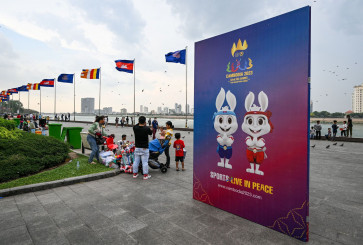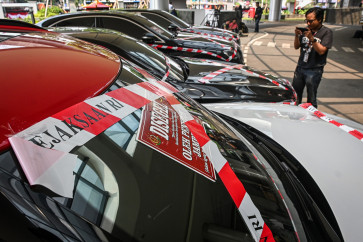Popular Reads
Top Results
Can't find what you're looking for?
View all search resultsPopular Reads
Top Results
Can't find what you're looking for?
View all search resultsTeaching art to the young, Korean-style
From the outside, the townhouse that houses Tomato Art School in Jakarta's Kebayoran area looks pretty inconspicuous with its pale green walls, sandblasted glass doors and a number of motorcycles parked randomly outside
Change text size
Gift Premium Articles
to Anyone
F
rom the outside, the townhouse that houses Tomato Art School in Jakarta's Kebayoran area looks pretty inconspicuous with its pale green walls, sandblasted glass doors and a number of motorcycles parked randomly outside.
Yet the moment one steps inside, colors begin to burst in a flow of creativity that makes the artist in you yearn to come out and play. Dominating the wall of the front lounge is a painting of an old Asian man viewed from profile. Inside the classrooms, colorful children's artworks are displayed alongside homemade figurines of clay and plasticine.
The works become more avant-garde up the second and third floors. A 3D painting of a horse, a bicycle wrapped and hanging from the ceiling, a mock television set with a squished painted face inside, a world map shaped of chocolate chip pieces, and an angel of death holding a broken earth with an African child lurking - all are testaments to the power of art wielded by today's imaginative youngsters and children.
The owner and resident teacher of the art school is Shin Don-cheol, an artist-of-all-trade who has spent the past decade teaching all things art to children and adults of various nationalities in Jakarta.
"Mister Shin", as he is normally addressed by students, moved to Jakarta from Seoul in the beginning of 1997. He had borne witness to Asia's monetary crisis, Indonesia's May riots and other turbulent events of the Indonesian Reformation, yet admitted he couldn't be more content about living here.
"I entered Seoul National University in 1983 to do Visual Communication Design," Shin recounted in fluent Indonesian.
After graduating, he worked as a graphic designer for five years, got married, had a child and spent some years as freelance illustrator - before a holiday trip to Bali turned their life around.
"We were grounded for 24 hours in Jakarta on our flight back to Seoul due to engine trouble. With a hotel voucher already in hand, I called up a Korean friend who had been living in Jakarta for some time; he took us around the city that night."
That ironic twist of fate helped Shin develop an instant liking for Jakarta. He decided to come back to do a bit of research before moving to the city permanently.
"Back in 1997, I was informed there were about 30,000 Koreans living in Indonesia," he said. The presence of international schools and restaurants and grocery stores selling Korean food in Jakarta - plus the reasonable size of the Korean community here - became further incentives for the move.
In 1998, Shin founded an art school to teach various art disciplines from drawing, painting and sculpture to printmaking, pottery, comic making and digital painting to children and adults. The school has recently moved to a townhouse in Kebayoran to make it more accessible to local students and arts enthusiasts.
Tomato's general manager Imad Yousry reckoned the school is very selective when it comes to recruiting suitable art teachers: "They have to have a passion to teach, be able to relate to children, and at the same time command a high level of art skills."
Over the years, students joining Tomato Art School have come from international schools like JIS, BIS, Binus and SPH, the majority of whom are Korean but could also have come from the US, Australia, Singapore, Pakistan, Europe and other parts of the globe.
Classes are divided into three age groups: kindergarten/elementary, junior (grade 7-9) and senior (grade 10-12 and adults). Sessions are arranged one or twice a week from one to three hours each, and each program lasts three months.
Among Tomato's major accomplishments is to successfully prepare students in gaining entrance to coveted art institutions like Parsons and Pratt Institute, New York, and the Rhodes Island School of Design in the US.
"We help them prepare a portfolio and bring out their best talents. Though the school has a basic art program, modules are adjusted to the student's focused interests to make learning more effective," said Shin, whose eldest daughter is currently embarking on a fine arts degree in the UK.
Tomato almost serves as a labor of love for Shin and his family. His Korean wife, a former elementary school teacher, is also involved in the running of the school and teaches introductory art classes for kindergarten and elementary students.
She had become pregnant with their second child while living in Jakarta. After going back briefly to Korea to give birth, the whole family was reunited again in the Indonesian capital.










